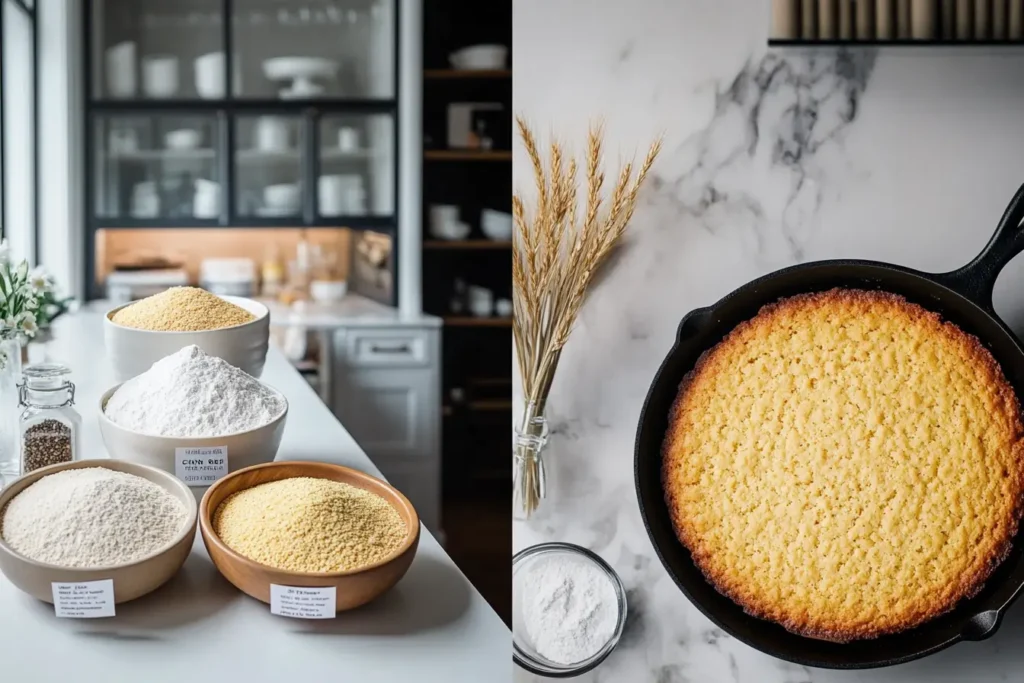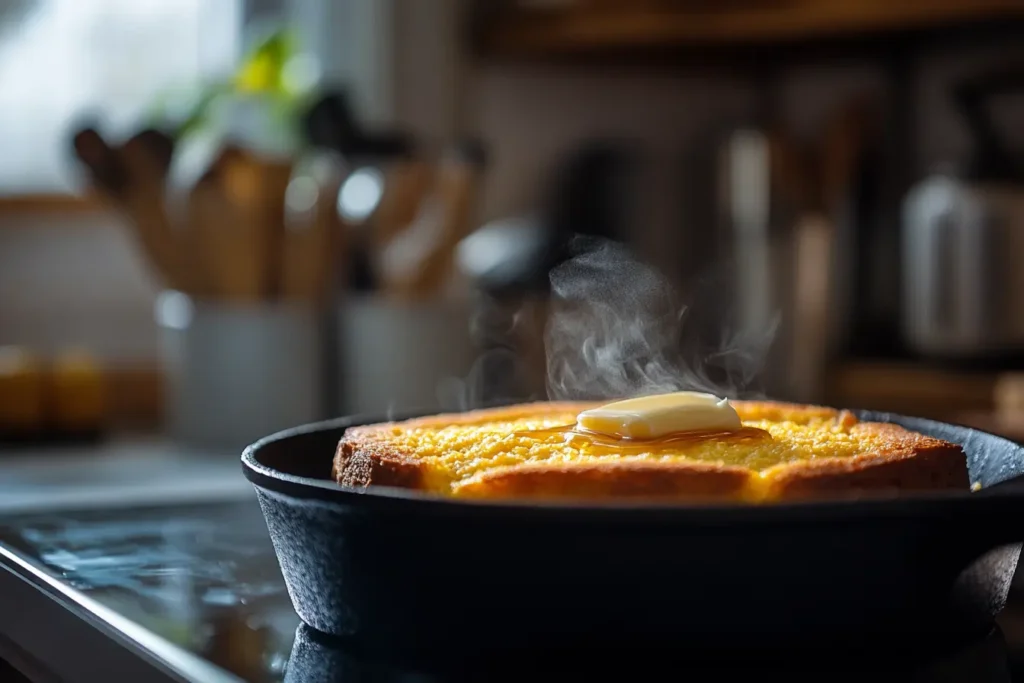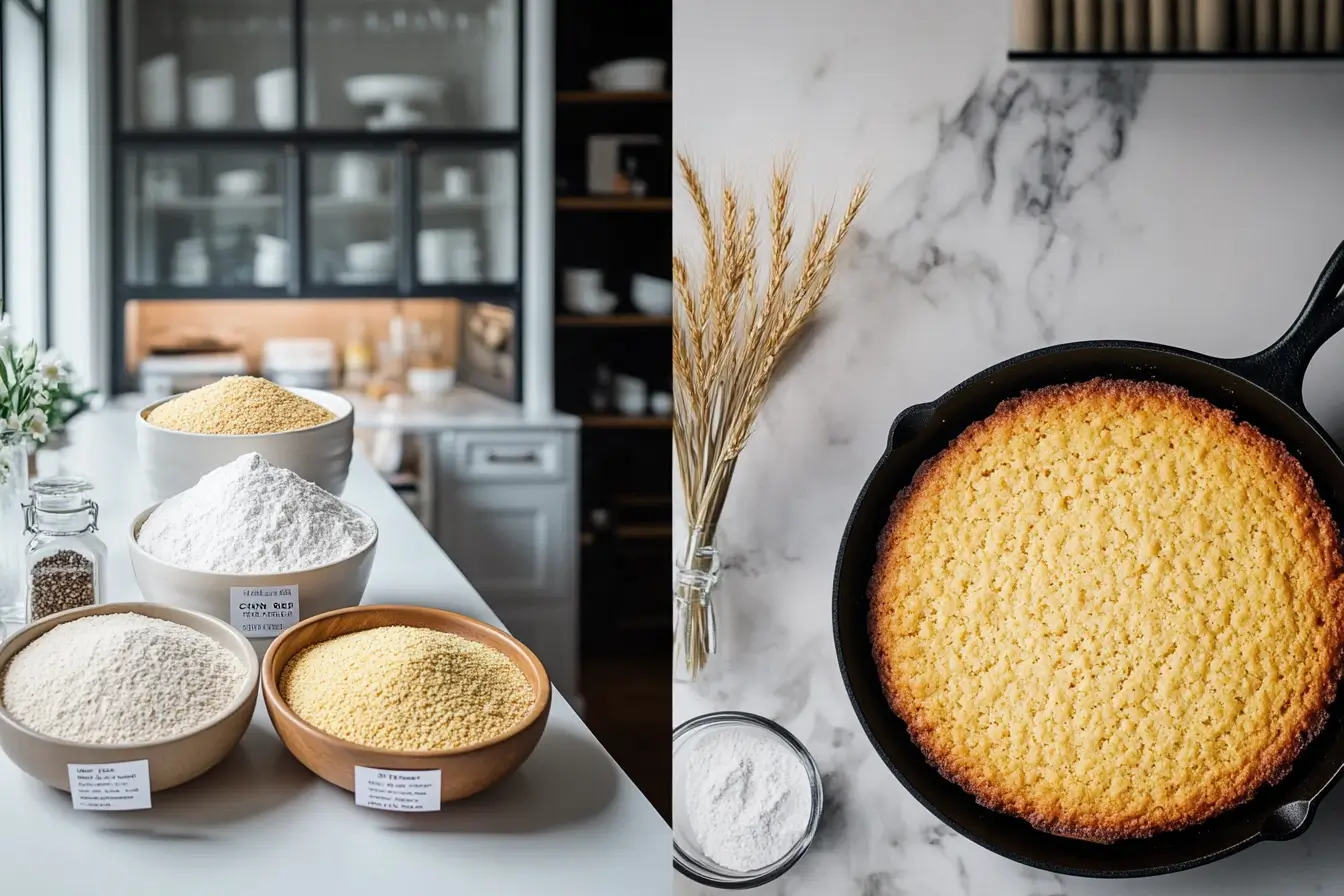
Cornbread—warm, golden, and inviting—has a special place in our hearts. Whether you’re pairing it with chili, frying it up as hushpuppies, or enjoying it as a standalone snack, it’s the type of comfort food that always hits the spot. But if you’ve ever found yourself staring at a supermarket aisle stacked with different kinds of cornmeal, you’ve likely asked: Which cornmeal is the best for cornbread?
Let’s take a deep dive into this corny conundrum, unraveling the mysteries of textures, flavors, and tips for achieving cornbread greatness.
Introduction to Cornmeal and Cornbread
Cornbread isn’t just a side dish—it’s a cultural icon. From its Native American roots to its cherished role in Southern cuisine, this simple yet satisfying dish has evolved into a beloved staple. And the key to great cornbread? You guessed it: the right cornmeal.
The Origin and Popularity of Cornbread
Cornbread’s history is as rich as its taste. Native Americans first ground dried corn to make simple cakes, which later influenced early settlers. Over time, cornbread became a Southern favorite, loved for its affordability, versatility, and flavor. Today, it’s celebrated at dinner tables across the country, holding its own against any other bread.
What is Cornmeal?
Cornmeal is essentially ground dried corn. But don’t be fooled by its simplicity—it’s a versatile ingredient that can completely change the outcome of your dish, depending on its type, grind, and processing. It’s the star player in cornbread, giving it that signature texture and flavor.
Types of Cornmeal

Not all cornmeal is created equal. The variety you choose can make the difference between cornbread that’s too dry, too grainy, or just perfect. Let’s break down the most common types.
Stone-Ground Cornmeal
Stone-ground cornmeal is like the old-school way of doing things. It’s ground on traditional millstones, retaining most of the corn’s germ and bran. This gives it a slightly nutty flavor and a coarser texture. Stone-ground cornmeal is ideal for those who want their cornbread with a bit more bite and earthiness.
“If you’re looking for rustic, flavorful cornbread that feels like a warm hug from history, stone-ground cornmeal is your best bet.” 🌽
Regular (Steel-Ground) Cornmeal
Steel-ground cornmeal, on the other hand, is the modern alternative. The germ and bran are removed during processing, giving it a finer, smoother texture. While it’s less flavorful than stone-ground varieties, it’s easier to store and produces a softer, fluffier cornbread.
Whole-Grain vs. Degerminated Cornmeal
Here’s another twist: whole-grain cornmeal keeps all the natural oils and nutrients from the corn kernel, while degerminated cornmeal removes them for longer shelf life. Whole-grain options are healthier but can turn rancid quicker, so keep them in the fridge.
Key Differences in Cornmeal Textures
Ever wondered why some cornbread feels like cake while others are chunky and rustic? It’s all about the grind. Cornmeal comes in three main textures: fine, medium, and coarse.
Fine Ground Cornmeal
Fine ground cornmeal has the texture of flour. It’s perfect for creating silky-smooth cornbread that’s more like cake than bread. This is your go-to if you’re aiming for soft, melt-in-your-mouth results.
Medium Ground Cornmeal
A happy medium—literally. Medium ground cornmeal strikes a balance between texture and smoothness, making it the most versatile choice for traditional cornbread recipes.
Coarse Ground Cornmeal
Coarse ground cornmeal is chunky and robust. It adds a hearty texture to cornbread, making every bite feel substantial. If you like a rustic, toothsome quality, this is the way to go.
Choosing the Right Cornmeal for Cornbread
So, which cornmeal should you choose? It all boils down to your preferences and the kind of cornbread you want to bake.
Flavor Considerations
Do you love bold, nutty flavors? Stone-ground cornmeal is packed with earthy tones. Prefer something more neutral? Steel-ground cornmeal will keep things mild and let your other ingredients shine.
Texture Preferences
If you’re aiming for cornbread that crumbles in your hands but melts in your mouth, fine ground cornmeal is ideal. For a rustic, chewy texture, opt for coarse ground. And if you’re undecided, medium ground offers the best of both worlds.
“Texture is like the personality of your cornbread—choose wisely!” 🧁
Nutritional Factors
Health-conscious bakers, take note: whole-grain cornmeal packs more fiber and nutrients. However, its oils can spoil quickly, so it’s best for smaller batches.
Popular Brands and Their Cornmeal Products
Shopping for cornmeal can feel overwhelming with so many brands vying for attention. Let’s highlight a few tried-and-true options.
Bob’s Red Mill Cornmeal Options
Bob’s Red Mill is a favorite among home bakers for its high-quality products. Their stone-ground cornmeal comes in various textures, making it easy to find the perfect match for your recipe.
Martha White vs. White Lily Cornmeal
Southern brands like Martha White and White Lily have a loyal following. Both offer finely milled cornmeal that’s perfect for traditional Southern-style cornbread.
Local and Artisan Cornmeal Brands
Don’t overlook local or artisan mills! These often produce cornmeal with unique flavors, perfect for experimenting in the kitchen. Plus, you’ll be supporting small businesses. 💛
Most Common Problems with Cornmeal in Cornbread
Cornbread may seem simple, but it’s surprisingly easy to mess up. Dry, crumbly, or bland cornbread? Been there, done that. Let’s tackle some of the most common cornbread issues and learn how to fix them.
Why Does Cornbread Turn Out Dry?
Dry cornbread is one of the most frequent complaints. Nobody likes a mouthful of crumbs that feels like eating sand! This usually happens because the batter doesn’t have enough moisture or the cornbread has been overbaked.
Solutions:
- Use a combination of milk and butter for added richness and moisture.
- Add sour cream, yogurt, or creamed corn to the batter.
- Watch the baking time like a hawk. Pull it out as soon as the edges are golden and a toothpick comes out clean.
“A splash of buttermilk can work wonders—it’s like giving your cornbread a big ol’ hug of creaminess.” 🥛
How to Avoid Grainy Texture in Cornbread
Cornbread that feels too gritty can ruin the experience. This is often caused by using coarse cornmeal without balancing it with other ingredients.
Solutions:
- Mix coarse cornmeal with medium or fine ground to soften the texture.
- Let the batter rest for 10–15 minutes before baking. This allows the cornmeal to absorb the liquid and soften.
- Blend your cornmeal with a small amount of flour for a smoother finish.
Solving Flavor Imbalance in Cornbread
Ever had cornbread that tastes either too sweet or too bland? Getting the flavor balance right can be tricky, especially when recipes vary so much.
Solutions:
- Adjust sugar levels based on your taste. Traditional Southern cornbread is savory, but Northern styles lean sweet.
- Experiment with add-ins like honey, cheese, jalapeños, or fresh corn kernels to amp up the flavor.
- Don’t forget the salt—it enhances all the other flavors and makes your cornbread pop.
Tips for Making the Perfect Cornbread
Perfecting cornbread is like mastering an art. It takes the right tools, ingredients, and techniques. Here are some tips to elevate your cornbread game.
Combining Cornmeal Types for Unique Results
Why stick to one type of cornmeal when you can mix them up? Combining different textures, such as medium and coarse ground, can create cornbread that’s both fluffy and hearty.
The Role of Ingredients in Enhancing Cornbread
Your ingredients are your building blocks. High-quality cornmeal is a must, but don’t stop there.
Key Ingredients to Consider:
- Fat: Butter or oil adds richness and prevents dryness.
- Liquid: Buttermilk gives tanginess, while whole milk adds creaminess.
- Sweeteners: Honey or sugar can balance the flavors without overpowering the cornmeal’s natural nuttiness.
Techniques to Achieve a Moist and Flavorful Crumb
Moist cornbread is the dream, and a few simple techniques can help you get there.
- Preheat Your Pan: Heating the skillet or baking dish ensures a crispy crust while keeping the inside tender.
- Don’t Overmix: Stir your batter just until the ingredients combine. Overmixing can make the cornbread dense.
- Add Extra Moisture: Incorporate ingredients like sour cream, Greek yogurt, or even a dollop of mayonnaise for extra creaminess.
“Think of your batter as a baby—handle it gently, and it’ll reward you with sweet, tender results.” 🍼
Recipe Spotlight: Classic Cornbread with Cornmeal

Now that you know the secrets to great cornbread, let’s put it into action with a classic recipe that never fails.
Ingredients for Traditional Cornbread
Here’s what you’ll need to whip up a delicious batch of cornbread:
- 1 cup medium-ground cornmeal
- 1 cup all-purpose flour
- 1 tablespoon sugar (adjust to taste)
- 1 teaspoon salt
- 1 teaspoon baking powder
- 1/2 teaspoon baking soda
- 1 cup buttermilk
- 2 large eggs
- 4 tablespoons melted butter (plus extra for greasing)
Step-by-Step Preparation Process
- Preheat Your Oven: Set it to 400°F (200°C) and place a cast-iron skillet inside to heat up.
- Mix Dry Ingredients: In a large bowl, whisk together the cornmeal, flour, sugar, salt, baking powder, and baking soda.
- Combine Wet Ingredients: In another bowl, mix the buttermilk, eggs, and melted butter until smooth.
- Blend Wet and Dry: Slowly pour the wet mixture into the dry ingredients. Stir just until combined.
- Heat and Pour: Carefully remove the skillet from the oven, grease it with butter, and pour in the batter.
- Bake: Bake for 20–25 minutes, or until the top is golden and a toothpick comes out clean.
- Serve: Let it cool slightly before slicing. Enjoy warm with butter or honey.
“There’s nothing quite like pulling a skillet of golden cornbread out of the oven. The smell alone is worth the effort!” 🍞✨
Alternative Uses for Cornmeal in the Kitchen
Cornmeal isn’t just for cornbread! It’s a surprisingly versatile ingredient that can level up your cooking and baking game.
Beyond Cornbread: Other Cornmeal Recipes
Looking to get creative? Try using cornmeal to make polenta, cornbread muffins, or even tamales. It’s also fantastic in pancakes for an extra hint of crunch.
Cornmeal as a Coating or Thickener
Cornmeal makes an excellent breading for fried chicken or fish, giving it a crispy, golden crust. You can also use it to thicken soups, stews, or sauces for a heartier texture.
Gluten-Free Options with Cornmeal
Because it’s naturally gluten-free, cornmeal is a lifesaver for those avoiding wheat. Use it to create gluten-free pizza crusts, tortillas, or desserts like cornbread pudding.
Frequently Asked Questions About Cornmeal and Cornbread
Curiosity often leads to better cooking! Here are some frequently asked questions to address common doubts and deepen your understanding of cornmeal and cornbread.
What Is the Best Cornmeal for Southern Cornbread?
Southern cornbread thrives on authenticity. The best choice is stone-ground cornmeal, which retains the natural oils and nutrients, giving the bread a rich flavor and rustic texture. To see how it’s done, check out this Southern Cornbread Recipe for an authentic approach.
Should I Use Buttermilk or Regular Milk in Cornbread?
Buttermilk is often the top choice for cornbread as it adds a tangy flavor and helps tenderize the crumb. However, regular milk can work in a pinch, especially if you adjust the recipe with a splash of lemon juice. For more insights, explore this helpful guide: Buttermilk or Milk for Cornbread?.
What’s the Difference Between Southern Cornbread and Regular Cornbread?
The main difference lies in the flavor and sweetness. Southern cornbread is typically savory, with minimal sugar, while regular cornbread (often Northern-style) leans sweet. Want to dive deeper into the differences? This comparison on Southern Cornbread vs. Regular Cornbread has you covered.
Can I Substitute Cornmeal in a Recipe?
Cornmeal can sometimes be replaced with polenta or grits, but the texture and flavor will differ. Fine-ground grits work best for cornbread as they mimic the texture of cornmeal. However, for the most authentic results, stick to medium or stone-ground cornmeal.
Conclusion: Which Cornmeal is Best for Cornbread?
Cornbread isn’t just a side dish; it’s a story, a tradition, and a culinary masterpiece. As we’ve explored, the type of cornmeal you choose can transform your cornbread, turning it from average to extraordinary. Whether you prefer the rustic texture of stone-ground cornmeal or the smooth finish of steel-ground, there’s a type for every taste and recipe.
Experiment with different textures and blends, and don’t hesitate to explore classic Southern recipes for inspiration. Remember, cornbread is as versatile as it is comforting—so have fun with it!
“Great cornbread starts with great cornmeal. Choose wisely, bake with love, and savor every crumb.” ❤️
Now it’s your turn to bring this golden delight to life. Happy baking! 🌽🍞

